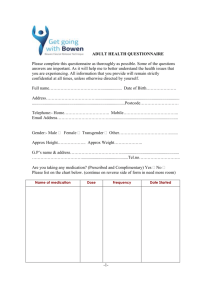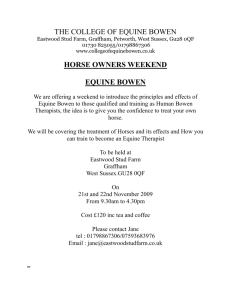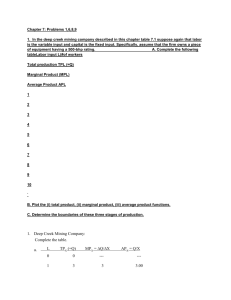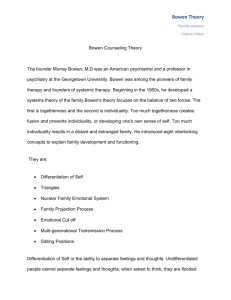Bowen Therapy - Hong Kong Pain Society
advertisement
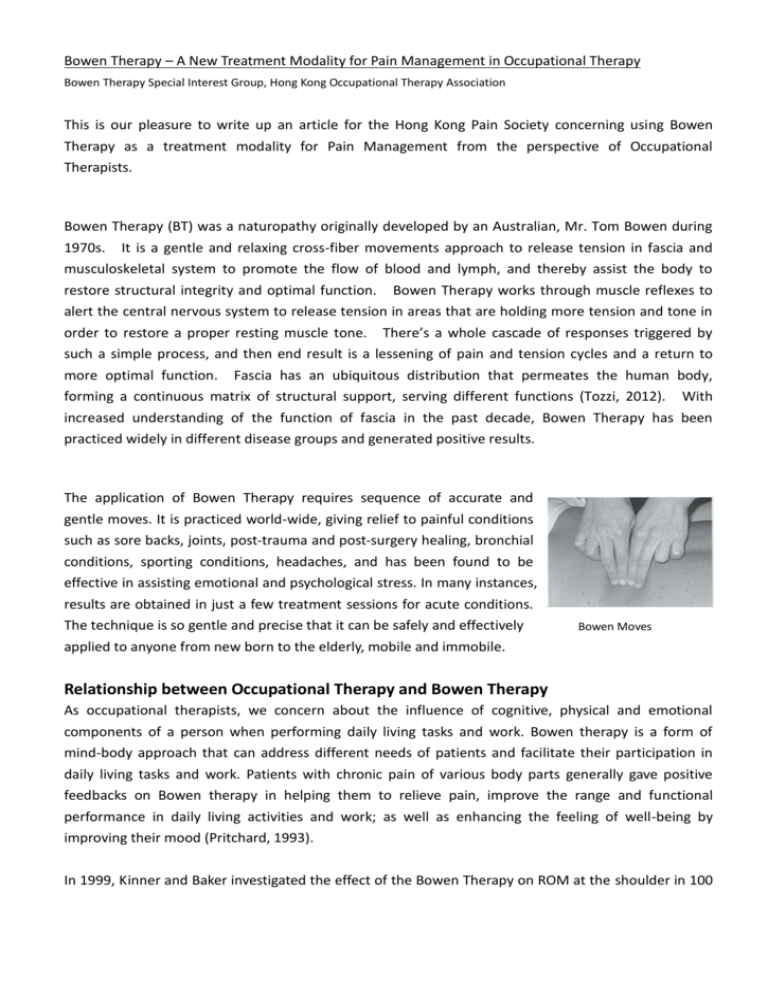
Bowen Therapy – A New Treatment Modality for Pain Management in Occupational Therapy Bowen Therapy Special Interest Group, Hong Kong Occupational Therapy Association This is our pleasure to write up an article for the Hong Kong Pain Society concerning using Bowen Therapy as a treatment modality for Pain Management from the perspective of Occupational Therapists. Bowen Therapy (BT) was a naturopathy originally developed by an Australian, Mr. Tom Bowen during 1970s. It is a gentle and relaxing cross-fiber movements approach to release tension in fascia and musculoskeletal system to promote the flow of blood and lymph, and thereby assist the body to restore structural integrity and optimal function. Bowen Therapy works through muscle reflexes to alert the central nervous system to release tension in areas that are holding more tension and tone in order to restore a proper resting muscle tone. There’s a whole cascade of responses triggered by such a simple process, and then end result is a lessening of pain and tension cycles and a return to more optimal function. Fascia has an ubiquitous distribution that permeates the human body, forming a continuous matrix of structural support, serving different functions (Tozzi, 2012). With increased understanding of the function of fascia in the past decade, Bowen Therapy has been practiced widely in different disease groups and generated positive results. The application of Bowen Therapy requires sequence of accurate and gentle moves. It is practiced world-wide, giving relief to painful conditions such as sore backs, joints, post-trauma and post-surgery healing, bronchial conditions, sporting conditions, headaches, and has been found to be effective in assisting emotional and psychological stress. In many instances, results are obtained in just a few treatment sessions for acute conditions. The technique is so gentle and precise that it can be safely and effectively applied to anyone from new born to the elderly, mobile and immobile. Bowen Moves Relationship between Occupational Therapy and Bowen Therapy As occupational therapists, we concern about the influence of cognitive, physical and emotional components of a person when performing daily living tasks and work. Bowen therapy is a form of mind-body approach that can address different needs of patients and facilitate their participation in daily living tasks and work. Patients with chronic pain of various body parts generally gave positive feedbacks on Bowen therapy in helping them to relieve pain, improve the range and functional performance in daily living activities and work; as well as enhancing the feeling of well-being by improving their mood (Pritchard, 1993). In 1999, Kinner and Baker investigated the effect of the Bowen Therapy on ROM at the shoulder in 100 patients with shoulder dysfunction and pain. Following a course of three Bowen treatments, shoulder ROM demonstrated significant improvements when compared with a placebo group. Whilst their results present evidence to support changes in participants with pathology, Kinner and Baker's (1999) study did not measure change in pain. In 2002, Cater studied the effectiveness of five Bowen Therapy treatments in the management of 20 patients with frozen shoulder in terms of pain, functional ability and wellbeing. This study was a case series that used primarily quantitative methods and qualitative interviews. Reports of improved shoulder mobility and associated function were observed, with 70% of subjects gaining a return in movement equal to their non-affected side. The results indicated that all participants, even for those with longstanding history of shoulder injury, had experienced relief in pain, improvement in shoulder mobility and ADL performance after receiving Bowen therapy. Marr and others (2011) carried out a prospective, randomized control study on 120 asymptomatic volunteers. Results revealed significant within-subjects and between subject differences for the Bowen group on hamstring flexibility. There is continuing increases in flexibility levels were observed over one week for the Bowen group. James (2008) has applied Bowen Therapy on cases with low back pain and positive result reported. There are also a number of unreported case studies to demonstrate that Bowen Therapy is effective to reduce pain in lower back, or for symptoms of Parkinson disease and asthma. Application of Bowen Therapy by Local Occupational Therapists Bowen therapy has been practiced in Hong Kong by more than 100 local occupational therapists (OT) who are certified practitioners of Bowen therapy since 2009. Two senior occupational therapists are qualified as clinical educators to teach the course in Hong Kong. Given the positive results of BT, it has become one of the treatment modalities adopted by OTs in both public and private health care settings. It has been integrated into our daily clinical practice in treating a multitude of ailments ranging from shoulder, neck and back pain that is musculoskeletal related; muscle tightness resulted from radiotherapy, such as NPC, breast cancer or visceral conditions such as asthma, stomach or kidney problems to headache. Bowen therapy demonstrated to be effective for pain relief in the above studies which are carried out in oversea. Recently, a preliminary randomized control trial study is undergoing by local occupational therapists to study the effectiveness of BT performed by OT in improving occupational performance for people with shoulder pain. Subjects are allocated into BT group or Sham BT (SBT) or Control group. The interim result is encouraging as all patients received BT showed improvement in their occupational performance, range of motion and decrease of shoulder pain in 10 sessions. There were significant differences among the three groups in pain scale (p=0.017); shoulder flexion (p=0.007); shoulder extension (p=0.04); shoulder abduction (p=0.07) and shoulder internal rotation (p=0.04) (Figure 1). Figure 1. Comparison of Performance Components among three groups The functional performance in terms of DASH were significantly different among the three groups with p=0.01. All the variables showed significant time effect in ANOVA for repeated measures (Figure 2). Figure 2. Comparison of Occupational Performance among three groups One of the limitations of application of Bowen therapy is the lack of adequate clinical trials to validate its effects statistically to different chronic pain condition. Further studies on the clinical application of Bowen Therapy to various pain conditions are the directions to prove its effectiveness in different disease groups to improve the quality of patient care. This paper illustrates that a gentle, relieving and non-invasive technique known as Bowen Therapy (BT) has been applied by trained Occupational Therapist for people with chronic pain with positive results in musculoskeletal related conditions. Series of article of the application of BT in oncology or visceralrelated pain by Occupational Therapist will be published in the future newsletters. Reference Carter B. (2002) A pilot study to evaluate the effectiveness of Bowen Technique in the management of clients with frozen shoulder. Complementary Therapies in Medicine, 9: 208-215. Tozzi, P. (2012) Selected fascial aspects of osteopathic practice. Journal of Bodywork & Movement Therapies 16: 503-19. James, E. (2008) Case Study: Bowen technique for back pain and other conditions, Positive Health, 2008 Jan, 38-39. Kinnear, H., Baker, J., (1999) Frozen shoulder research programme. European College of Bowen Studies, unpublished. Marr, M., Baker J., Lambon, N., and Perry, J. (2011) The effects of the Bowen technique on hamstring flexibility over time: A randomized controlled trial. Journal of Bodywork & Movement Therapies, 15: 281 - 290 Pritchard, A.G. (1993) The Psychophysiological Effects of the Bowen Technique. Unpublished article Rasco, J. (2009) The effectiveness of the Bowen Technique on Motor Function and Quality of Life for those with Parkinson's Disease Rattray, A. (2002) The Bowen technique and sport - a winning formula. Massage World, July/August, 21-23. Rattray, A. Godfrey, J. (2002) The Bowen technique - Remarkable results with respiratory problems. Nurse 2 (8), 61-62
